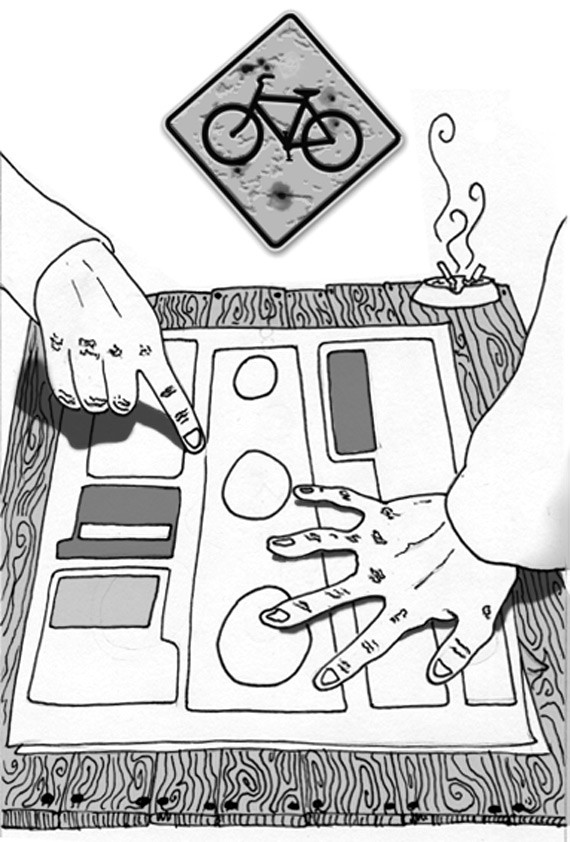Four of the city's most substantial institutions---Dalhousie and Saint Mary's universities, the IWK and Capital Health---are co-operating to create a "Bikeways Plan" in the south end, which they have named the "Urban Halifax Institutional District."
"It's a large area," says Mark Nener, a community planner with Dalhousie's Cities and Environment Unit. "The ballpark number for the district is 40,000 total daily trips for all staff, students and visitors."
The idea to make the area more accessible for bicycle commuting came from Dalhousie's Transportation Demand Working Group. Dal planners are working with the other institutions, with community input, to develop a cycling plan---a "bold vision for the future of cycling," as the press release says.
So far, the newly formed Bicycle Action Committee has held two public sessions to discuss the concept. Nener says the sessions were attended mostly by current cyclists, including daily commuters and casual cyclists, with a few people interested in cycling but afraid for their safety.
"There were probably more representatives from Dalhousie than the other institutions," Nener admits. "We'll be going to Saint Mary's and the IWK for lunch sessions."
The goal of the gatherings is to learn about preferred routes and typical challenges cyclists encounter. For example, Vernon to Seymour Street is a popular route across Coburg Road, but they are misaligned at the intersection, creating confusion for cyclists and motorists. The other end of Vernon becomes Quingate, a popular throughway that is technically illegal---all vehicles must turn onto Quinpool at that intersection.
Merging onto Bell Road after crossing through the south Common is also tricky. Every intersection around the Common is a hazard, particularly Agricola/North Park and Cunard, according to the workshop participants. And University Avenue, which all four institutions use, is full of moving and parked cars, a haven for "dooring" incidents.
Based on this feedback, the BAC will write a plan identifying priority routes into and around the district and design interventions, physical features that keep bikes and cars at a safe distance. Bike parking and storage will be considered and the group is considering a bike-sharing system allowing staff and students to commute using other modes and hopping on a bike to attend meetings and classes around campus.
Nener is confident funding will be quickly raised for implementation, mainly because the advisory committee includes representatives from each of the four institutions, HRM, the Halifax Cycling Coalition and the Nova Scotia Bikeways Coalition. "There's a variety of expertise," he says.
The collaborative approach improves the odds of attracting funding from multiple sources including government, the institutions themselves and other local businesses. Nener adds that the city has "expressed interest in new models for investing in sustainable development."
Ross Soward, who represents the Halifax Cycling Coalition on the advisory committee, calls the Bikeways project "proof of some strong leadership within these institutions." He notes that when large institutions take an interest in cycling it shows a real cultural shift. "The HCC is excited and encouraged by the growing recognition of the need for improved [cycling] infrastructure and facilities."
Nener's team is also conducting secondary research into "best practices," things institutions have done in other jurisdictions. "The University of Ottawa is known for its progressive work on transportation demand."
While taking stock of what has worked elsewhere is a wise move, Soward urges Halifax "to develop our own local vernacular of cycling infrastructure to demonstrate that cycling has great potential to serve as form of transportation for a variety of trips." In other words, if Halifax can latch onto a growing national trend toward active transportation in ways consistent with our own culture, cycling can escape the fringes.
The concept of creating a cycle-friendly "institutional district" goes a long way to mainstreaming the bike, making daily bicycle commuting safer and more popular. As Mark Nener puts it: "The most exciting thing is the potential to capture new riders interested but concerned, feeling unsafe, with the current infrastructure."
The Bicycle Action Committee will present its plan at an open house March 23, 4:30pm at the Dalhousie Student Union Building. It's a final chance for the public to suggest changes before implementation.
Chris Benjamin is the author of the critically acclaimed novel Drive-by Saviours.













